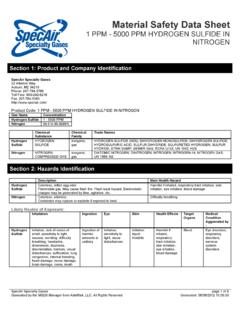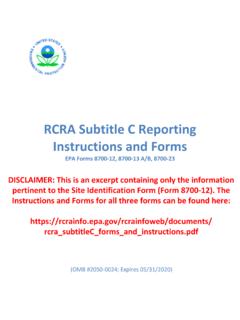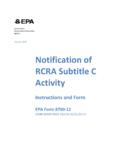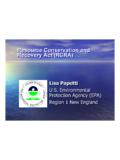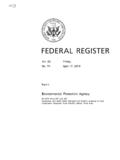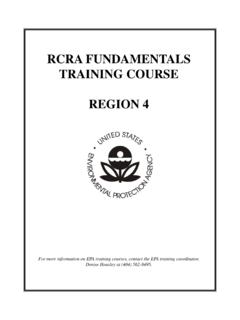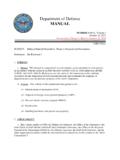Transcription of RCRA Subtitle D Regulations - LANDTEC North America
1 TechTips RCRA Subtitle D Regulations Upcoming Regulations will affect owners and operators of new and existing Municipal Solid Waste Landfills. The new Regulations establish revised minimum federal criteria that include location restrictions, facility design and operating criteria, groundwater and landfill gas monitoring requirements, corrective action requirements, financial assurance require- ments, and closure and post-closure care requirements. Individual state restrictions can be more stringent than federal Subtitle D standards.
2 This Technical Tip offers the reader highlights of the Environmental Protection Agency's (EPA) Resource Conservation and Recovery Act (RCRA) Subtitle D, 40 CFR Parts 257 and 258 requirements. It is not inclusive and the original docu- ment should be thoroughly read and understood by the reader before implementing any portion of the document. The goal of Subtitle D. The goal of the EPA's RCRA Subtitle D is to establish a framework for federal, state and local government cooperation in controlling the management of nonhazardous solid waste.
3 The federal role is to establish the overall regulatory direction, by providing minimum nationwide standards for protecting human health and the environment, and to provide technical as- sistance to the State for planning and developing their own environmentally-sound waste management practices. The actual planning and direct implementation of solid waste programs under Subtitle D remains with state and local regulators. The EPA retains the authority to enforce the appropriate standards in a given state.
4 When does This Take Effect? Who is Affected? Subtitle D (Subpart A) affects new, existing and lateral expansions of Municipal Solid Waste Landfills (MSWLF) that receive household waste on or after October 9, 1993. It does not apply to MSWLF that ceased receipt of waste by October 9, 1991. There are some exemptions which extend the date to April 9, 1994. MSWLF units that stop receiving waste by October 9, 1993, must comply with specified closure requirements only. States who participate in the implementation of the new Regulations must adopt and implement approved permit programs.
5 Otherwise, the federal Regulations establish minimum standards. New Subtitle D Requirements Location Restrictions (Subpart B): New and lateral expansions of MSWLF have location restrictions regarding airport, floodplains, unstable areas, wetlands, seismic impact zones and fault areas. Existing MSWLF's have location restrictions regarding only airports, floodplains and unstable areas. Operating Criteria (Subpart C): All new, existing and lateral expansions of MSWLF must implement the following op- erating criteria: Procedures for excluding hazardous waste: Must have a program to detect and prevent disposal of regulated haz- ardous waste and PCBs (polychlorinated biphenyls).
6 Daily cover: A 6-inch minimum cover of earthen material or State approved alternative must be applied at the end of each operating day, or more frequently if necessary, to prevent or control on-site populations of disease vectors, fires, odors, blowing litter and scavenging. Disease vector control: Must prevent or control on-site populations of disease vectors. Page 1 of 4. RCRA Subtitle D Regulations TechTips Air criteria: Must meet requirements of State Implementation Plan under Clean Air Act.
7 Open burning is prohibited, except for the infrequent burning of agricultural wastes, land clearing debris, diseased trees or debris from emergency cleanup operations. Access requirements: Must control public access, prevent unauthorized traffic and prevent illegal dumping. Run-on/run-off control: Must have a plan to design, construct and maintain a control system to prevent flow onto an active area from the peak discharge of a 25-year storm and to collect and control the water volume resulting from a 24-hour, 25-year storm.
8 Surface water requirements: Must prevent discharge of pollutants and the discharge of a nonpoint source of pollution to waters of the United States that violates any requirements on the Clean Water Act. Explosive gases control: Methane gas must not exceed 25 percent of LEL ( by volume) in on-site structures and cannot exceed methane LEL (5% by volume) at site boundary. Gases must be monitored at least quarterly. EPA Explanation: The decomposition of solid waste produces methane, an explosive gas.
9 The accumulation of methane in MSWLF structures can result in fire and explosions that can injure or kill employees, users of the disposal site, and occupants of nearby structures, and can damage containment structures and thereby cause the emission of toxic fumes. The type and frequency of monitoring depends of site specific factors that control the rate and extent of gas migration. These factors include: soil, hydrogeologic and hydraulic conditions surrounding the disposal site, and the location of facility structures relative to property boundaries.
10 The EPA believes that the minimum quarterly monitoring accounts for the seasonal varia- tion in subsurface gas migration patterns. If methane limits are exceeded, necessary steps to ensure protection of human health must be taken along with immediate notification to the State of the level detected and the steps taken to protect human health. Such steps could include evacuation and ventilation of affected buildings. EPA also proposed that the owner or operator submit a remediation plan to the State within 14 days of the methane content being exceeded.
